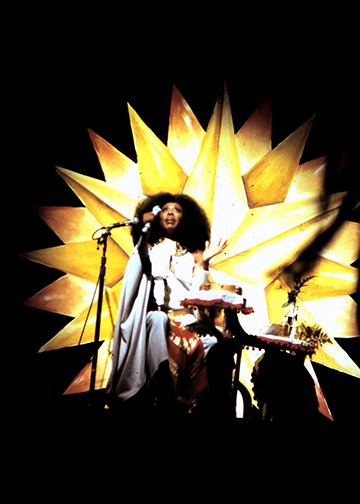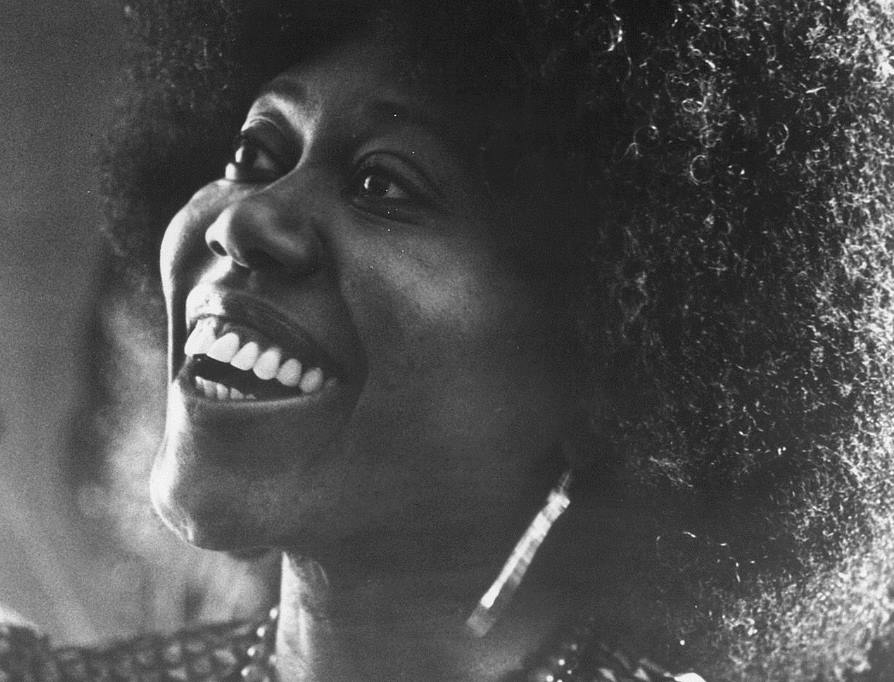“I believe the need for a (Black cultural art form) is far more critical even than the issue of white racism…All Black artists must begin either to build, or to support, Black theatres in all the Black communities in America,” theatres that “should be concerned with the truth of our lives.”
Those are the words of Barbara Ann Teer, writing in The New York Times in 1968. That same year she put her own words into action in Harlem. More than a theatre, the National Black Theatre would be a place to build and celebrate a culture that was uniquely African American. And while most of the theatres founded in those heady days have long since burned out, NBT still stands at the intersection of 125th Street and 5th Avenue, a monument to Black arts that continues to find ways to nourish and nurture Black artists.
What brought Teer to that intersection? Originally a dancer, she graduated from the University of Illinois with a degree in dance education at the age of 19 in 1956, and then studied and performed in Europe at her professor’s invitation. In 1959 she moved to New York City, coincidentally the same year that A Raisin in the Sun opened on Broadway, the first play written by a Black woman, and the first directed by a Black man, to reach the Main Stem. She met the Raisin cast and entered a phase in which, as she would later describe it, she “got very involved with Blackness…I started studying Afro-Cuban dance then and jazz…I started reading books, political books, about Black people and their relationship in this country.”
Then, at a pivotal moment, Teer sustained an injury to her knee and hence couldn’t dance regularly. She soon began theatre studies at the Henry Street Playhouse, believing that acting gave her a discipline, a mental power, and a sense of totality in her work. In 1961 she appeared in her first Broadway show, Kwamina, which closed after 32 performances. In subsequent years she would continue to work on and Off-Broadway and in TV and film, and would win a Drama Desk and several Obie Awards. By any standard, she was enjoying a successful career. But throughout this journey she was dissatisfied. The Western dance aesthetic had no room for jazz, she felt, and as for the plays she did, she felt they “never dealt with me as an individual. And since white people were writing all the plays, you would get one-dimensional characters—the Black people anyway.”
In 1964 she began working with Robert Hooks and the Group Theatre Workshop. She took naturally to teaching, as she came from a family of teachers; soon she was working with youth at the Group, producing a show that featured them called We Real Cool, based on the Gwendolyn Brooks poem of the same name. The piece got Joseph Papp’s attention, and he put it on with the Public Theater’s Mobile Unit as a traveling show that made its way around the city. This work led Teer to an important realization: that, despite her extensive training, “the technique I had acquired could not channel” the power and emotion of those Black teenagers.
In 1967 the Group Theatre Workshop became the Negro Ensemble Company, and this is where Teer went her own way. “My philosophy was that we should not be called Negroes and we should not be located in Greenwich Village,” she later explained of the break. “I didn’t want to prove to white people that I could do their Western art form as good as they could.” The theatre she would later found would be a rejection of everything she had learned about Eurocentric theatre and what it represented. She rejected the idea of scarcity, and the rejection she felt was built into the theatrical business as usual. “The audition is like being on a slave block,” she said. “It is not nurturing, and it separates you from yourself and from God.”
Her daughter, Sade Lythcott, the NBT’s current CEO, says that Teer “was interested in the liberation of our oppressed story. What if acting was about God consciousness—a ritual in feeding that energy?”
But as Teer resisted Eurocentric cultural norms and the “Negro” label, her efforts were being resisted as well. Some people thought she shouldn’t leave the realm of the “white” theatre, as she was one of its very few successful Black women actors. Activism and the Black Arts movement were dominated by men. According to Woodie King Jr., founder and producing director of the New Federal Theatre and a longtime friend of Teer’s, “The atmosphere was very macho. A brilliant—and beautiful—woman comes into their midst, these men didn’t know how to deal.”

She did not allow any of that to affect her work. Her decision to start her theatre in Harlem only strengthened her ties to the Black Arts Movement. The space where the theatre was located, at the corner of 125th and 5th, was in the same space as the Studio Museum of Harlem and the Last Poets. Amiri Baraka was down the street; Teer was personally close to James Baldwin and the Shabazz family. All these connections and relationships in the movement were important to the work she began at that time. She did not call her company members actors; she called them Liberators.
She and her Liberators “sacrificed our egos, our desire to act, and went about the task of establishing a Black theatrical standard—a standard based on the Black lifestyle.” She saw her task as nothing less than healing the violence and trauma inflicted on Black lives. Like many experimental theatres of the time, hers was more concerned with process than product. Classes included “Meditation and Spiritual Release” and “Liberation Theory.” Teer was concerned with all aspects of Black life. She saw the spirit as the core of Black existence, and hence developed what she called the Teer Technology of Soul, a training process based in the traditions, rhythms, and active participation inherent in both the Pentecostal church and in African traditions. She believed that African Americans have a duality of culture and that both sides must be honored. She brought Pentecostal preachers into the theatre so that her company and her students could learn “preacher rhythms.”
Later the Ford Foundation offered Teer a fellowship to travel to Africa, in what would be the first of more than 30 trips to the continent. Her second stop on that first trip was Nigeria, where, according to Lythcott, she found home. “She discovered the pantheon of Black gods, and for someone who had studied the Greeks, it was a game changer,” Lythcott says. This connection to the African spirit was incorporated into her work, and brought home in the form of specially commissioned works by seven traditional and contemporary Nigerian artists from the Osun-Osogbo Sacred Grove, who carved interior and exterior artwork using tools and methods spanning seven generations. Teer’s collection of this work is the largest of its kind in the Western Hemisphere, and continues to inspire the artists gathered in the theatre every day.
She made the theatre a home for the artists and for the people of Harlem. “She recognized home as the first pressure point of the trauma of Black people,” says Lythcott. “Systematically the family was torn apart, but here (the theatre) you were welcomed to your home—she was tapping into blood memory.”
She hosted regular Sunday symposia called “The Blackening Program,” which were “designed to fill a vacuum left by the media that do not accurately write stories concerning the Black community.” Lundeana Marie Thomas describes these events in her book Barbara Ann Teer and the National Black Theatre as addressing “almost every type of situation that exists in the Black community.” Symposia guests included Nikki Giovanni, Ruby Dee, Stokely Carmichael, Sonia Sanchez, Maya Angelou, and H. Rap Brown, among many other luminaries.
Lythcott recalls that Teer cherished the coordinates of the theatre’s address on the corner of 125th Street and 5th Avenue—the intersection of symbols of Black culture and of opulence, respectively. When, in 1983, the space burned down, the theatre raised money to buy the entire block three years later, becoming artist/entrepreneurs. The purchase of the building was a public/private partnership, but like most projects of this type the financing and completion took many years. Indeed its current leaders are still trying to fulfill the original vision, as buying property necessitated a shift from a company of artists dedicated to the artistic process to an entrepreneurial company owning real estate. Buying the building, Lythcott says, ensured that the theatre would always have a place and some security, but running a building has since taken some time and attention away from the art.
Teer stayed at her post until her death in 2008. Her funeral in July of that year was an event befitting a queen of Harlem: a coffin borne by a horse-drawn carriage, preceded by 40 African drummers and a parade that included an elephant (she loved elephants). At her funeral at Riverside Church, Roberta Flack sang and former mayor David Dinkins—to date NYC’s only African American mayor—spoke, as did many others. She had touched and changed countless lives, and the service was a celebration of her love.
More than 50 years after NBT’s founding, Teer’s work and spirit live on. Lythcott and artistic director Jonathan McCrory work to make sure that all who come into Teer’s theatre feel the spirit and the love she embodied. Her son, Michael Lythcott, is the chairman of the board of directors, and Nabii Faison, one of the original Liberators, continues to work there in the role of director of entrepreneurial arts. Among its offerings now are Liberating Artistic Bravery (LAB) programs, in which artists develop work of their choosing, free to focus not on commercial success or even on production but on all that the work can be. That sounds exactly like the kind of liberation Barbara Ann Teer worked for.
Deb Clapp is executive director of the League of Chicago Theatres.


